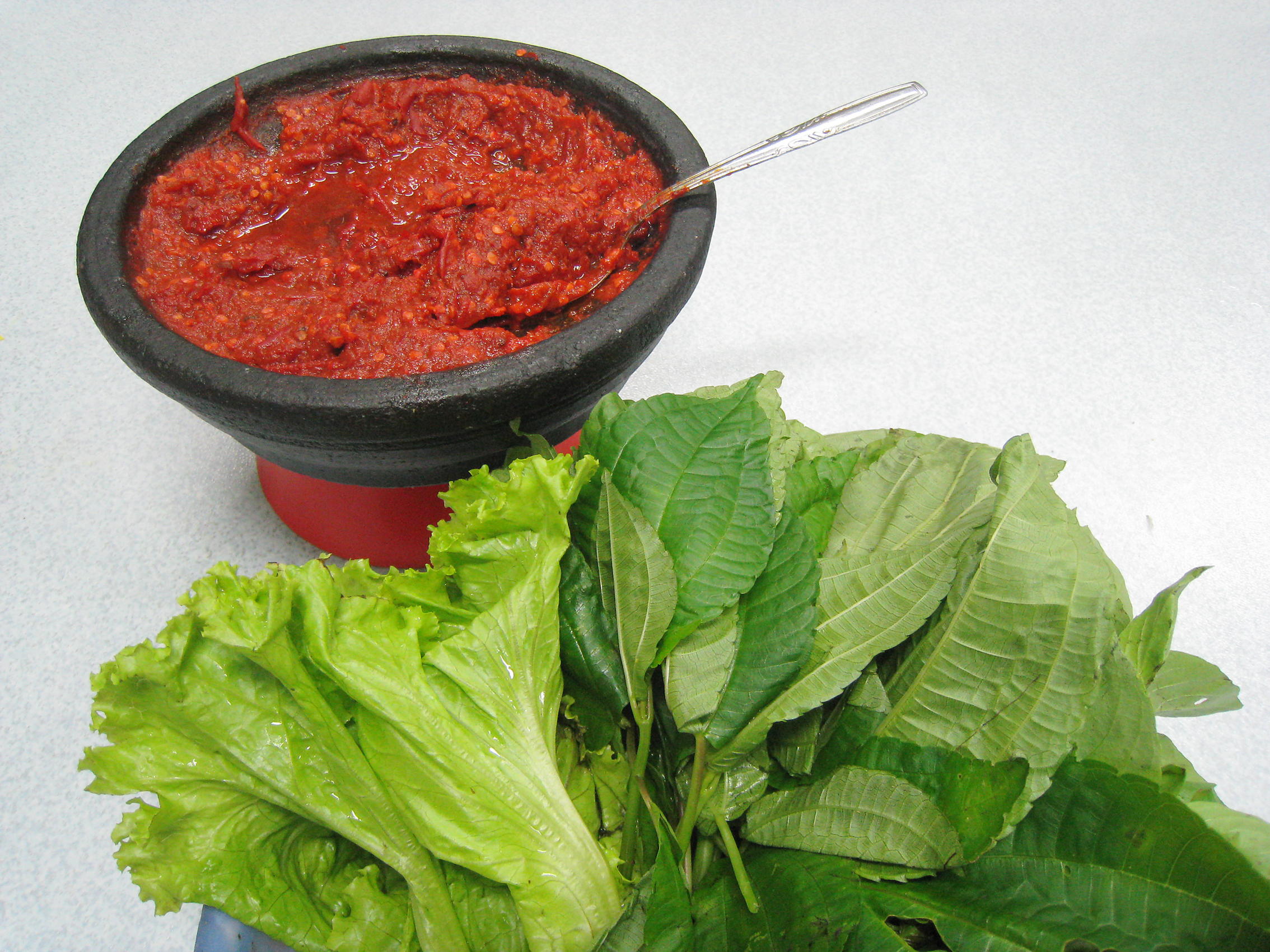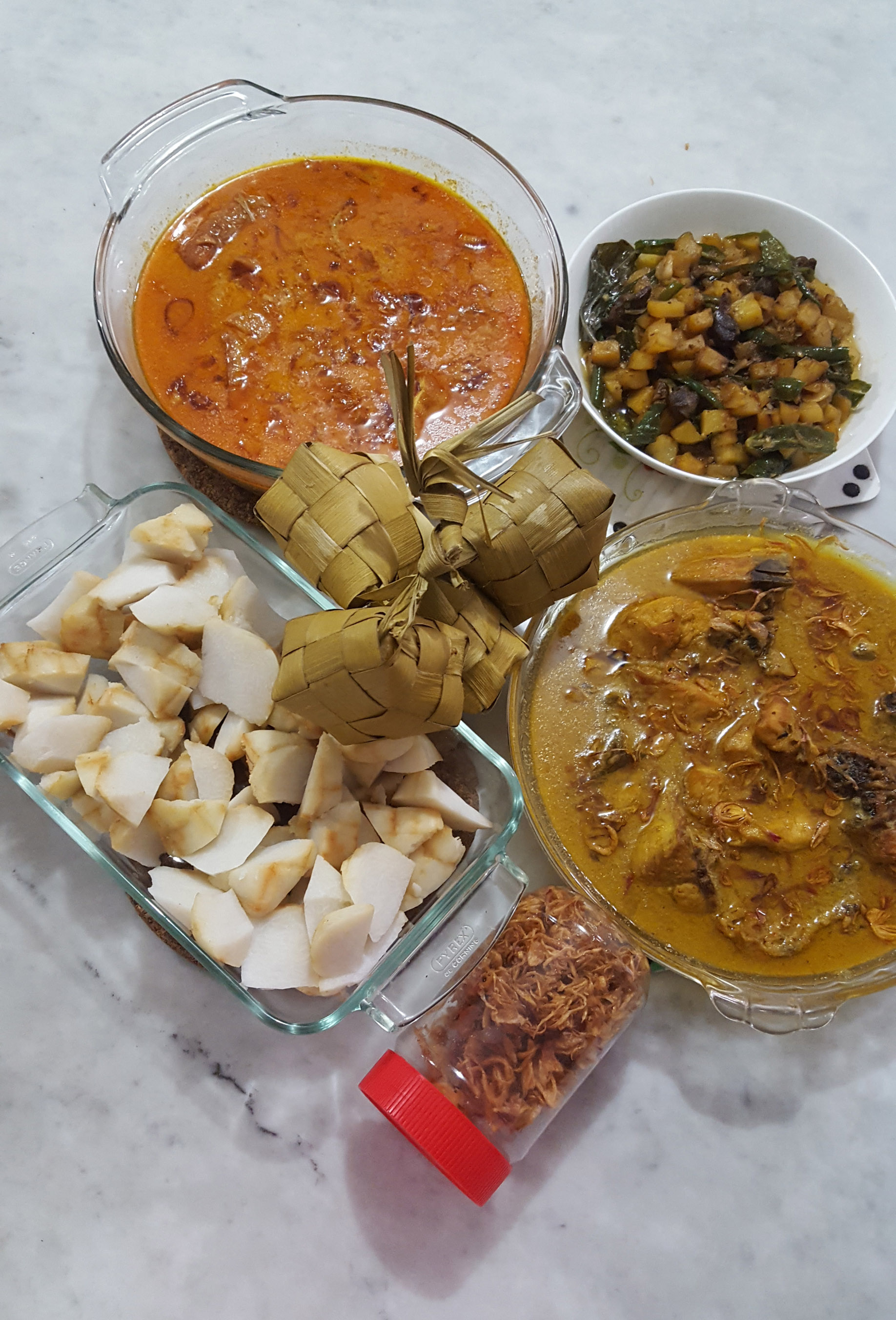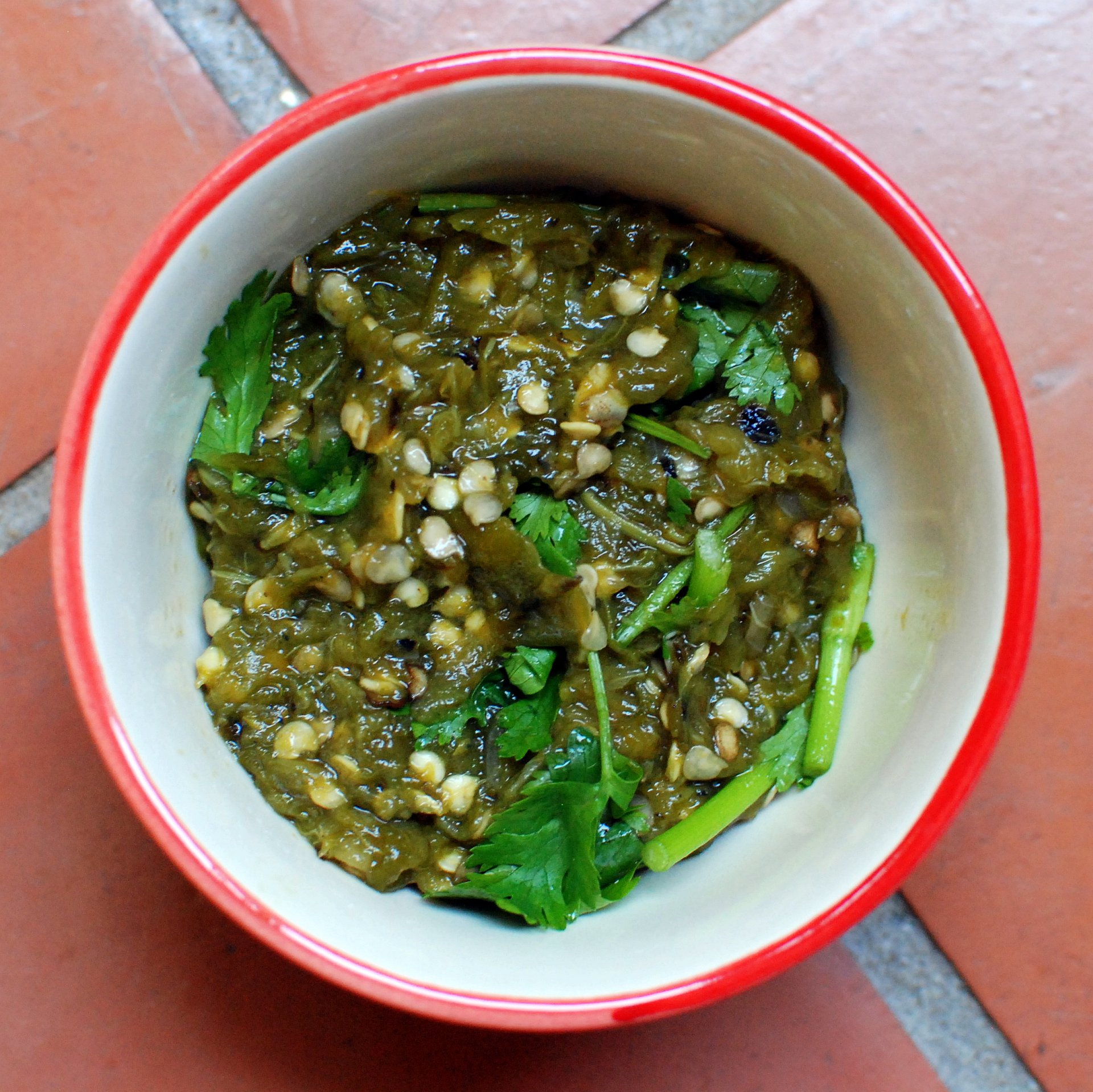|
Lalab
''Lalab'' (Sundanese: , ''Lalab'') or ''lalap/lalapan'' (Indonesian) is a Sundanese raw vegetable salad served with ''sambal terasi''. It is a popular Sundanese vegetable dish originated from West Java & Banten, Indonesia. There are no set rules on what vegetables make into lalab, in practice all edible vegetables can be made as lalab. However, the most common raw vegetables are cucumber, tomato, cabbage, lettuce, lemon basil, ''leunca'' and long beans. While blanched or boiled vegetables include spinach, papaya leaves and chayote. The dressing for this salad usually is ''sambal terasi'' served directly from the stone mortar as a spicy dipping sauce for these assorted raw vegetables. Today, ''lalab'' is popular throughout Indonesia. It is usually served as vegetable side dish next to the main course, such as ''ayam goreng'' (fried chicken), ''ayam bakar'' (grilled chicken), ''pepes'', '' pecel lele'' (fried catfish), fried gourami, and many other ''ikan goreng'' (fried fis ... [...More Info...] [...Related Items...] OR: [Wikipedia] [Google] [Baidu] |
Sundanese Cuisine
Sundanese cuisine is the cuisine of the Sundanese people of Western Java, and Banten, Indonesia. It is one of the most popular foods in Indonesia. Sundanese food is characterised by its freshness; the famous lalab eaten with sambal and also karedok demonstrate the Sundanese fondness for fresh raw vegetables. Unlike the rich and spicy taste, infused with coconut milk and curry of Minangkabau cuisine, the Sundanese cuisine displays the simple and clear taste; ranged from savoury salty, fresh sourness, mild sweetness, to hot and spicy. Sambal terasi is the most important and the most common condiment in Sundanese cuisine, and eaten together with lalab or fried tofu and tempeh. Sayur Asem vegetable tamarind soup is probably the most popular vegetable soup dish in Sundanese cuisine. Another popular soup is Soto Bandung, a soup of beef and daikon radish, and mie kocok noodle soup with beef meat and '' kikil''. Ingredients Fresh water fishes such as carp, gourami, tilapia and cat ... [...More Info...] [...Related Items...] OR: [Wikipedia] [Google] [Baidu] |
Ulam (salad)
''Ulam'' is a traditional salad produced from the fresh leaves, vegetables or fruits which can be eaten raw or after soaked in hot water e.g. ''Centella asiatica. It is'' typically eaten with sauces such as anchovies, ''cincalok'' or ''sambal.'' It is recognised as a popular vegetable dish in traditional villages. ''Ulam'' can be eaten simply as it is such as cucumber, cabbage and longbean. Another type of ulam is traditional ulam, in which it is used more as an ingredient, such as in ''nasi ulam'' (ulam rice), ''nasi kerabu'' (a type of bluish-coloured rice) and cooking with other vegetables. It also has its uses in ''Ayurvedic'' and traditional medicine, such as diabetes and high blood pressure. See also * Malay cuisine * List of salads * ''Lalab'' * ''Pecel'' * Rojak * ''Urap ''Urap'' (sometimes spelled ''urab'' or in its plural form ''urap-urap'') is a salad dish of steamed vegetables mixed with seasoned and spiced grated coconut for dressing. It is commonly found ... [...More Info...] [...Related Items...] OR: [Wikipedia] [Google] [Baidu] |
Sambal
Sambal is an Indonesian chilli sauce or paste, typically made from a mixture of a variety of chilli peppers with secondary ingredients, such as shrimp paste, garlic, ginger, shallot, scallion, palm sugar, and lime juice. ''Sambal'' is an Indonesian loan-word of Javanese origin (). It originated from the culinary traditions of Indonesia, and is also an integral part of the cuisines of Malaysia, Sri Lanka, Brunei and Singapore. It has also spread through overseas Indonesian populations to the Netherlands and Suriname. (Indonesian) Various recipes of ''sambals'' usually are served as hot and spicy condiments for dishes, such as ''lalab'' (raw vegetables), ''ikan bakar'' (grilled fish), ''ikan goreng'' (fried fish), '' ayam goreng'' (fried chicken), ''ayam penyet'' (smashed chicken), '' iga penyet'' (ribs) and various '' soto'' soup. There are 212 variants of sambal in Indonesia, with most of them originating from Java. History Sambal is often described as a hot and spicy In ... [...More Info...] [...Related Items...] OR: [Wikipedia] [Google] [Baidu] |
Indonesian Cuisine
Indonesian cuisine is a collection of various regional culinary traditions that formed the archipelagic nation of Indonesia. There are a wide variety of recipes and cuisines in part because Indonesia is composed of approximately 6,000 populated islands of the total 17,508 in the world's largest archipelago,"Indonesian Cuisine." . Accessed July 2011. [...More Info...] [...Related Items...] OR: [Wikipedia] [Google] [Baidu] |
Sambal
Sambal is an Indonesian chilli sauce or paste, typically made from a mixture of a variety of chilli peppers with secondary ingredients, such as shrimp paste, garlic, ginger, shallot, scallion, palm sugar, and lime juice. ''Sambal'' is an Indonesian loan-word of Javanese origin (). It originated from the culinary traditions of Indonesia, and is also an integral part of the cuisines of Malaysia, Sri Lanka, Brunei and Singapore. It has also spread through overseas Indonesian populations to the Netherlands and Suriname. (Indonesian) Various recipes of ''sambals'' usually are served as hot and spicy condiments for dishes, such as ''lalab'' (raw vegetables), ''ikan bakar'' (grilled fish), ''ikan goreng'' (fried fish), '' ayam goreng'' (fried chicken), ''ayam penyet'' (smashed chicken), '' iga penyet'' (ribs) and various '' soto'' soup. There are 212 variants of sambal in Indonesia, with most of them originating from Java. History Sambal is often described as a hot and spicy In ... [...More Info...] [...Related Items...] OR: [Wikipedia] [Google] [Baidu] |
Nam Phrik
''Nam phrik'' ( th, น้ำพริก, ) is a type of Thai spicy chili sauce typical of Thai cuisine. Usual ingredients for ''nam phrik'' type sauces are fresh or dry chilies, garlic, shallots, lime juice and often some kind of fish or shrimp paste. In the traditional way of preparing these sauces, the ingredients are pounded together using a mortar and pestle, with either salt or fish sauce added to taste. ''Nam phrik'' type sauces are normally served on small saucers placed by the main dish as a condiment or dip for bland preparations, such as raw or boiled greens, fish, poultry and meats. Depending on the type, the region and the family that prepares it, ''nam phrik'' may vary in texture from a liquid to a paste to an almost dry, granular, or powdery consistency. Instead of ''khrueang kaeng'' or ''phrik kaeng'', the words ''nam phrik'' can also be used to denote Thai curry pastes such as in ''nam phrik kaeng som'' for ''kaeng som'' or ''nam phrik kaeng phet'' for '' ... [...More Info...] [...Related Items...] OR: [Wikipedia] [Google] [Baidu] |
Sambal Lalab
Sambal is an Indonesian chilli sauce or paste, typically made from a mixture of a variety of chilli peppers with secondary ingredients, such as shrimp paste, garlic, ginger, shallot, scallion, palm sugar, and lime juice. ''Sambal'' is an Indonesian loan-word of Javanese origin (). It originated from the culinary traditions of Indonesia, and is also an integral part of the cuisines of Malaysia, Sri Lanka, Brunei and Singapore. It has also spread through overseas Indonesian populations to the Netherlands and Suriname. (Indonesian) Various recipes of ''sambals'' usually are served as hot and spicy condiments for dishes, such as ''lalab'' (raw vegetables), ''ikan bakar'' (grilled fish), ''ikan goreng'' (fried fish), ''ayam goreng'' (fried chicken), '' ayam penyet'' (smashed chicken), ''iga penyet'' (ribs) and various '' soto'' soup. There are 212 variants of sambal in Indonesia, with most of them originating from Java. History Sambal is often described as a hot and spic ... [...More Info...] [...Related Items...] OR: [Wikipedia] [Google] [Baidu] |
Sanghyang Siksakanda Ng Karesian
Sanghyang Siksa Kandang Karesian is a didactic text, providing the reader with religious and moralistic rules, prescriptions and lessons. The title means something like “the book of rules with guidance to be a '' resi'' (wise or holy man)”. This text is preserved in the National Library in Jakarta and identified as kropak 630; it consist of 30 gebang leaves (formerly identified as nipah) and in the lontar manuscript L624. The gebang manuscript is dated in a chronogram nora catur sagara wulan (0-4-4-1), that is Saka 1440 or 1518 AD. It had already been referred to in earlier publications by Holle and Noorduyn. A complete edition with translation, introduction, commentary and glossary was presented in a stenciled work by Atja and Danasasmita (1981a). It has been republished in book-form in Danasasmita et al. (1987:73-118). Text edition of the lontar manuscript has been done by Nurwansah, published in journal of Sundalana (2013). The text is from Galuh (a capital city of the Sund ... [...More Info...] [...Related Items...] OR: [Wikipedia] [Google] [Baidu] |
Old Sundanese Language
Old Sundanese (Sundanese script: , Old Sundanese script: , Buda script: , ) is the earliest recorded stage of the Sundanese language which is spoken in the western part of Java. The evidence is recorded in inscriptions from around the 12th to 14th centuries and ancient palm-leaf manuscripts from the 15th to 17th centuries AD. Old Sundanese is no longer used today, but has developed into its descendant, modern Sundanese. Written Evidence Old Sundanese is recorded in stone inscriptions such as the Kawali Inscription in Ciamis, and the Batutulis inscription in Bogor, as well as in inscriptions made from copper plates such as the Kabantenan inscription from the Bekasi area. Other remains documenting the use of Old Sundanese are palm-leaf manuscripts from the Bandung, Garut, and Bogor regions. The manuscripts are now stored in several institutions, including Kabuyutan Ciburuy in Bayongbong Garut, Sri Baduga Museum in Bandung, the National Library of Indonesia in Jakarta, and th ... [...More Info...] [...Related Items...] OR: [Wikipedia] [Google] [Baidu] |
Ikan Bakar
Ikan bakar is an Indonesian and Malaysian dish, prepared with charcoal-grilled fish or other forms of seafood. ''Ikan bakar'' literally means "grilled fish" in Indonesian and Malay. Ikan bakar differs from other grilled fish dishes in that it often contains flavorings like bumbu, kecap manis, sambal, and is covered in a banana leaf and cooked on a charcoal fire. Origin and popularity Grilling is one of the oldest and earliest cooking methods to prepare fish. Freshwater fish and seafood are among the main source of protein intake for the inhabitants of the archipelago. Naturally, this method is immensely popular and quite widespread in the maritime realm of Indonesian archipelago. Thus the grilled-barbecued fish is regarded as a classic dish of Indonesian cuisine. As an archipelagic nation, ''ikan bakar'' is very popular in Indonesia, commonly found in many places; from an Acehnese beach right down, a restaurant perched over Kupang's harbour in East Nusa Tenggara, to the center ... [...More Info...] [...Related Items...] OR: [Wikipedia] [Google] [Baidu] |
Cabbage
Cabbage, comprising several cultivars of ''Brassica oleracea'', is a leafy green, red (purple), or white (pale green) biennial plant grown as an annual vegetable crop for its dense-leaved heads. It is descended from the wild cabbage ( ''B. oleracea'' var. ''oleracea''), and belongs to the "cole crops" or brassicas, meaning it is closely related to broccoli and cauliflower (var. ''botrytis''); Brussels sprouts (var. ''gemmifera''); and Savoy cabbage (var. ''sabauda''). A cabbage generally weighs between . Smooth-leafed, firm-headed green cabbages are the most common, with smooth-leafed purple cabbages and crinkle-leafed savoy cabbages of both colours being rarer. Under conditions of long sunny days, such as those found at high northern latitudes in summer, cabbages can grow quite large. , the heaviest cabbage was . Cabbage heads are generally picked during the first year of the plant's life cycle, but plants intended for seed are allowed to grow a second year and must be ... [...More Info...] [...Related Items...] OR: [Wikipedia] [Google] [Baidu] |
Ikan Goreng
Ikan goreng is an Indonesian and Malaysian dish, consisting of deep fried fish or other forms of seafood. ''Ikan goreng'' literally means "fried fish" in Indonesian and Malay languages. Ikan goreng is very popular in Indonesia. Usually, the fish is marinated with mixture of spice pastes. Some recipes use ''kecap manis'' (sweet soy sauce) to coat the fish after being fried. ''Ikan goreng'' are usually deep fried in ample extremely hot coconut oil until the fish turns golden and crisp. This method is often used with carp, gourami and milkfish in order to turn the fine fishbone crumbly, crisp and edible. Spices Before frying, the fish is typically marinated with a mixture of various spices, and sometimes ''kecap manis'' (sweet soy sauce). The spices mixture may vary among regions and places, but usually it consists of combination of salt, lemon juice, ground shallot, garlic, chili pepper, coriander, turmeric, galangal and salt. Some recipes may employ batter or egg coating on ... [...More Info...] [...Related Items...] OR: [Wikipedia] [Google] [Baidu] |







